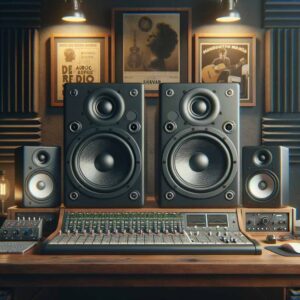Are you wondering how to make your mic sound better?
In my early recording days, I spent a bunch of money upgrading my microphone.
But yet, I was disappointed by my audio quality.
Over time, I learned that mic quality isn’t the end-all-be-all.
It doesn’t play as much of a role in your audio quality as you think.
Here’s a list of 10 things you can do – besides buying a new mic – to maximize your recording quality.
Overview
- Add Acoustic Treatment to your Space
- Eliminate Background Noises
- Use a Pop Filter or Windscreen
- Make Sure you’re Using High-Quality Cables
- Use a Shock Mount and Mic Stand to Eliminate Handling Noise
- Adjust Tone Shaping Switches
- Set your Gain Appropriately
- Use a High Gain Low-Noise Mic Preamp
- Use an External Mic Preamp (or Audio Interface with Preamp Emulations)
10 Ways to Make a Mic Sound Better
1. Add Acoustic Treatment To Your Space
The absolute best way to make a microphone sound better is by adding or improving the acoustic treatment in your recording room.
In fact, the acoustic in your room makes up about 80% of your audio quality, while the other 20% can be attributed to your mic.
Using a better mic will only highlight the acoustic deficiency in your recording space.
Benefits of Acoustic Treatment
Adding acoustic treatment to your space will absorb and reflect sound in critical areas.
The goal is to prevent your mic from capturing unwanted reverberations, resulting in a cleaner, more focused sound.
How To Acoustically Treat Your Room
First, you want to make sure your recording room has plenty of furniture to absorb sound and prevent echoes.
Consider adding a futon/couch, rug, and acoustic curtains to your space.
From there, you’ll want to focus on a few key problem areas.
The first is the area around the microphone. Another area is the corners of your room. And lastly, any windows.
Bass Traps and Diffusers
One way to treat these areas is by using Bass Traps.
Bass traps absorb low frequencies to prevent muddy-sounding recordings.
Another option is to use diffusers, which help reflect sound waves and prevent them from bouncing off walls and ceilings.
By scattering the sound waves, diffusers can create a more even sound throughout the room.
Acoustic Treatment Placement
When positioning your acoustic treatments, you’ll want to place them in strategic positions around the room.
For example, you can place bass traps in corners and diffusers along the walls.
Experiment with different positions and listen to how it affects your audio quality.
Acoustic treatment can be an investment, but it’s worth it if you want to take your sound to the next level.
Acoustic Treatment Without Spending Money
If you’re on a budget, you can do a few things to improve the acoustic in your room without spending any money.
One is to move your furniture around. This will change the way sound bounces off of surfaces in your room.
Another method is to place a mattress, blanket, or pillows next to your mics. These objects will help deaden sound and make your room more acoustically friendly.
Microphone Isolation Booth/Shield
If you’re in an apartment, on a budget, or recording on the go, consider a microphone isolation booth (or shield) like the Auray ISO-ARMOR-2.
2. Eliminate Background Noises
Eliminating any sources of background noise will improve the quality of your recordings.
While this sounds obvious, there are many discrete sources of background noise you may not catch until you play back your audio.
Here are a few to consider:
Keep your Mic Away from your Computer
A computer’s cooling fan is a common source of background noise.
If possible, move your microphone as far from your computer as possible.
If your mic has a cardioid polar pattern, you can point the back toward your computer.
A cardioid mic rejects noise from the back. As a result, it won’t pick up fan noise.
Turn Off Air Conditioning and Fans
Fans are another common source of background noise.
Even the quietest fans can ruin your recordings since they cause air to hit your mic capsule.
Make sure to turn off any nearby fans.
Close Windows and Doors
Traffic, neighbors, and other exterior noises can ruin your takes.
Close all the windows and doors in your recording room to minimize these distractions.
3. Use a Pop Filter or Windscreen
Another piece of equipment you can use to improve your recording quality is a pop filter (for condenser mics) or a windscreen (for dynamic mics).
A pop filter is a circular mesh you can place 4-5 inches away from your mic. It’ll prevent plosives (hard “p” and “b” sounds) from hitting your microphone.
Otherwise, they’ll cause unwanted pops in your recordings.
A windscreen serves a similar purpose but mainly for dynamic microphones.
They both disperse or deflect blasts of air (from your mouth) to create an even sound distribution.
A pop filter/windscreen will also prevent moisture from reaching your mic capsule and causing it to rust.
Simply put, using a pop filter is one of the easiest ways to get better audio recordings.
Not only will it improve the quality of your recordings, but it will also protect your microphone from damage.
4. Make Sure you’re Using High-Quality Cables
The quality of your mic cables also affects how your microphone sounds.
Cheap XLR cables can
introduce all sorts of noise and distortion into your signals.
They’re also susceptible to interference from electrical equipment and other electronic devices.
Invest in high-quality cables if you’re serious about getting the best sound possible from your microphone.
5. Use a Shock Mount and Mic Stand to Eliminate Handling Noise
There are several benefits of using a shock mount on a microphone – improved sound quality, reduced handling noise, and protection from vibration.
A shock mount isolates a microphone from external vibrations.
It also helps reduce handling noise by absorbing some of the energy from movements.
Additionally, shock mounts can protect microphones from damage.
6. Adjust Tone Shaping Switches
Some microphones have frequency shaping switches you can use to alter the tone of your audio.
For instance, the Shure SM7B has a bass roll-off and a mid-range emphasis switch.
The bass roll-off switch attenuates low frequencies, which can help reduce “muddiness” in your recordings.
The MID switch emphasizes mid-range frequencies to add “clarity” and “presence” to your audio.
Frequency shaping switches are excellent for customizing your recording to achieve your desired sound.
If you’re unsure which settings to use, a good rule of thumb is to start with the flat setting and make adjustments from there.
Experiment with different settings until you find the perfect sound for your needs.
7. Set your Gain Appropriately
Here are some general guidelines to help you properly set your gain:
First, determine the sensitivity of your microphone.
This information is usually available in the manufacturer’s specifications.
Once you know the sensitivity of your microphone, you can determine how much gain you will need from your preamp.
If you are using a dynamic microphone, you will typically need more gain than if you are using a condenser microphone.
Next, determine the maximum SPL (sound pressure level) that your microphone can handle. This information is also available in the manufacturer’s specifications.
The maximum SPL will tell you how much gain you can apply to your signal without distorting it.
Once you know the sensitivity of your microphone and the maximum SPL it can handle, you can start setting the gain on your preamp.
Start with the gain set at its lowest setting and slowly increase it until you reach the desired level.
If you start to hear preamp noise or distortion, back off on the gain until your audio sounds clean again.
If you’re using a large percentage of your preamp’s available gain to drive your mic, you’ll risk increasing preamp noise.
8. Use a High Gain Low-Noise Mic Preamp
Your mic preamp has a significant impact on your recording quality.
Why?
Microphones output weak signals.
Therefore, you’ll need a mic preamp to boost your mic signal to the proper level for recording (line level).
These days, most audio interfaces have great preamps for condenser mics.
However, dynamic mics output an even weaker signal than condenser mics (i.e., the Shure SM7B).
As a result, we recommend you pair your dynamic mic with a high-gain audio interface for the best results.
Since dynamic mics require more gain, you may find yourself setting your gain to its maximum setting to get a good signal from your mic.
However, using 100% of your gain (especially if your preamps have a high EIN) can add a staticky hissing noise to your recordings (preamp noise).
With a high-gain mic preamp, you can supply the proper amount of gain to your mic without maxing out – resulting in cleaner recordings.
If your audio interface doesn’t deliver a clean signal from your dynamic mic, you can also use a Cloudlifter.
A Cloudlifter supplies an additional 25 dB of gain, which gives you more headroom.
9. Use an External Mic Preamp (or Audio Interface with Preamp Emulations)
As mentioned before, Microphone preamplifiers (or simply “preamps”) amplify microphone signals to a level compatible with the input of a recording device or mixing console.
Many preamps also provide EQ, gain, and other functions to shape the sound of your mic signal.
Conveniently, most audio interfaces have built-in mic preamps, but you can also purchase an external unit.
The two main types of microphone preamps are tube and solid state.
Tube preamps use vacuum tubes in their circuitry. They’re known for their warm, smooth sound.
There are many different types of tube mic preamps on the market, each with its own unique sonic character. Some popular models include the API 512c, Neve 1073, and Vintage King V76.
Solid-state preamps use solid-state circuitry.
Unlike tube preamps, they deliver a transparent signal. In other words, they won’t change the tone of your audio by adding warmth, brightness, etc.
Most audio interfaces have solid-state mic preamps, but external units tend to offer more gain and less preamp noise.
Some audio interfaces have tube preamp features.
These features tend to emulate the characteristics of vintage analog mic preamps.
For instance, the Focusrite Scarlett 2i2 offers Air mode – inspired by Focusrite’s ISA mic preamp – which can add “brightness” to your audio.
When shopping for a tube mic or solid-state preamp, it’s important to consider what type of sound you’re looking for.
Do you want a clean, transparent sound?
Or are you going for a more vintage, gritty sound?
There are many great options out there, so it’s just a matter of finding the right one for your needs.
Plus, connecting an external mic preamp to your audio interface is simple. Check out our step-by-step guide.
10. Use Plug-ins
Add an EQ
Use an equalizer (EQ) to shape your sound.
An EQ can help you eliminate unwanted frequencies (i.e., too much low end) and emphasize the ones you want (i.e., not enough high end).
Compress your Audio
Adding compression can even out your levels to ensure your voice isn’t too loud or quiet throughout your track.
Use Noise Reduction Plug-ins
If you’re in a noisy environment, you may need a noise reduction plug-in to improve your audio quality.
I like the Izotope RX noise reduction software for this. But there are plenty of great ones out there.
You can also add reverb to add life to dull recordings.
Add Reverb
Reverb simulates the sound of your voice in different environments (i.e., small room, large hall, etc.) and creates more natural-sounding audio.
Just be careful not to overdo it.
Summary: How to Make a Mic Sound Better
And there you have it; ten things you can do to improve your audio quality.
Buying a “better” mic doesn’t always do the trick.
There are plenty of other factors that influence your recordings.
Acoustic treatment is the most important one.
Many audio professionals agree that anyone with a limited budget should spend at least 70% on acoustic treatment.
You can also eliminate unwanted noises by using a pop filter, shock mount, and low noise mic preamp.
Some mics come with tone-shaping switches to adjust frequency response.
You can even change the tone of your audio by running your mic through an external tube preamp.
Once you have a vocal signal that you’re happy with, you can make further improvements in the mixing stage.








